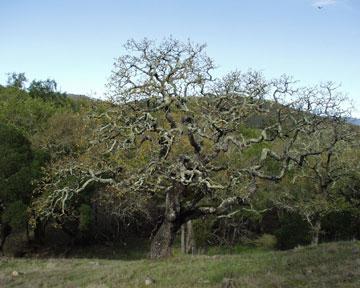Gardening Near Native Oaks

(Photo: Black Oak) One of the most peaceful sights in Californa is a majestic oak surrounded by native bunch grasses and wild flowers. The oak tree has worked out a fine balance over thousands of years of mutual existence in its habitat. California's climate consists of a dry and a rainy season with the rainy season occuring in the winter when the soil is cool and the dry season corresponding to the summer months when the soil and air are much warmer. This warm season would have ideal conditions for disease causing fungi that can attack oak roots except that these fungi also need moisture to become active. That is why it's so important not to unbalance the system by adding summer water to the site. If you water when it's warm you risk activating the native fungi thus slowly killing your oak.
When development occurs in oak woodlands the native flora is often disturbed and needs to be restored. There are a few simple rules that should be kept in mind when doing this in order to maintain the health of your oak tree. First, don't plant anything within at least a 10 foot radius from the trunk of the tree. To control undesirable weeds a thin layer of mulch can be used in this area as long as it doesn't come in contact with the trunk. Second, drought tolerant plants should be used at least to the edge of the dripline. Summer watering can then be kept at a bare minimum, not more than once a month. The ideal method of watering is drip irrigation to keep the water localized. Smaller containers, one gallon or less, are best to start with as they cause the least disturbance to the roots of the oak tree and adapt more quickly. The best time to introduce new plants is October through March when the soil is cool and moist. Third, keep it simple. The structure and simplicity of the oak tree speaks for itself.































